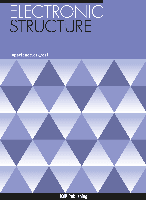
Electronic Structure
Scope & Guideline
Exploring the Frontiers of Electronic Properties
Introduction
Aims and Scopes
- Theoretical and Computational Methods:
The journal emphasizes the development and application of theoretical frameworks and computational techniques, including density functional theory (DFT), many-body perturbation theory, and quantum Monte Carlo methods, to understand electronic structures. - Material Science and Engineering:
It covers research on the electronic properties of various materials, including metals, semiconductors, and insulators, with a focus on their applications in electronics, photonics, and energy storage. - Nanostructures and Low-Dimensional Systems:
Research on two-dimensional materials, nanostructures, and their unique electronic properties is a significant area of interest, exploring phenomena such as quantum confinement and topological effects. - Interdisciplinary Applications:
The journal encourages interdisciplinary studies that connect electronic structure theory with other fields such as chemistry, biology, and engineering, addressing complex problems like catalysis, energy conversion, and drug design. - Emerging Technologies:
It focuses on the electronic structure of materials relevant to emerging technologies, including quantum computing, optoelectronics, and advanced battery materials, making significant contributions to innovation.
Trending and Emerging
- Advancements in Machine Learning Applications:
There is a growing trend in applying machine learning techniques to electronic structure calculations, enhancing predictions and optimizing computational workflows, indicating a shift towards integrating AI in computational materials science. - Quantum Computing and Electronic Structure:
Research related to quantum computing methods for electronic structure simulations is on the rise, reflecting the potential of quantum technologies to revolutionize material design and analysis. - Exploration of Two-Dimensional Materials:
The study of 2D materials, such as transition metal dichalcogenides and graphene, has gained significant traction, focusing on their unique electronic properties and potential applications in next-generation devices. - Dynamics and Ultrafast Phenomena:
There is an increasing focus on ultrafast dynamics and time-resolved studies of electronic processes, which are crucial for understanding phenomena in photonics and optoelectronics. - Interfacial and Hybrid Systems:
Research on interfacial phenomena and hybrid systems, particularly in the context of organic-inorganic interfaces and layered materials, is emerging as a critical area of study for enhancing performance in electronic and energy applications.
Declining or Waning
- Traditional Bulk Material Studies:
While bulk material studies remain relevant, the focus has shifted toward more complex systems such as nanostructures and heterostructures, leading to a decreased emphasis on conventional bulk material electronic structure analysis. - Static Models of Electronic Structure:
There is a waning interest in static models that do not account for dynamic interactions, as researchers increasingly seek to incorporate time-dependent effects and non-equilibrium dynamics in their studies. - Classical Approaches to DFT:
Research utilizing classical approximations of density functional theory has become less prominent as more sophisticated and accurate methods are developed, such as hybrid functionals and advanced perturbative techniques. - Simplistic Defect Studies:
Investigations focusing solely on simple defect states in materials are declining, with a growing preference for studies that explore complex defect interactions and their implications on material properties. - Single-Disciplinary Perspectives:
The journal has seen a reduction in publications that adopt a single-disciplinary approach, as interdisciplinary research that combines insights from multiple fields is increasingly favored.
Similar Journals

Science China-Physics Mechanics & Astronomy
Pioneering Research in Fundamental and Applied PhysicsScience China-Physics Mechanics & Astronomy, published by SCIENCE PRESS, stands as a prestigious journal within the Physics and Astronomy domain, particularly recognized for its contributions to the understanding of fundamental and applied physics. With an exhilarating Q1 ranking in the 2023 category and earning a remarkable scopus rank of #21 out of 243, the journal demonstrates its significant impact, being positioned in the 91st percentile of its field. Operating under an Open Access model, it facilitates the broad dissemination of high-quality research, ensuring accessibility for researchers, professionals, and students worldwide. Its scope covers a variety of essential topics in physics and astronomy, promoting a comprehensive understanding of the latest advancements from 2010 through 2024. The journal is a vital resource for anyone aiming to stay at the forefront of research in these dynamic fields, with its prominent address located in Beijing, China, symbolizing its global influence.

PHYSICS OF THE SOLID STATE
Exploring Innovations in Condensed Matter PhysicsPhysics of the Solid State is a distinguished journal published by Pleiades Publishing Inc., focusing on the rapid advancements and fundamental research in the realms of condensed matter physics, electronic, optical, and magnetic materials. With an ISSN of 1063-7834 and an E-ISSN of 1090-6460, this journal serves as a crucial platform for disseminating high-quality research findings, insights, and reviews essential for both academic and industrial professionals in the field. As of 2023, its Scopus ranking places it in the 26th percentile for both Condensed Matter Physics and Electronic, Optical and Magnetic Materials, reflecting its evolving influence and contribution to the scientific community. Although currently classified in the Q4 quartile, the journal aims to foster interdisciplinary dialogue, improve research visibility, and enhance its impact on contemporary scientific challenges through rigorous peer-reviewed articles and focused special issues. Despite its traditional model of access, it continues to play a pivotal role in engaging researchers and fostering innovation in solid-state physics.
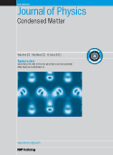
JOURNAL OF PHYSICS-CONDENSED MATTER
Transforming Ideas into Impactful Solutions in Physics.JOURNAL OF PHYSICS-CONDENSED MATTER, published by IOP Publishing Ltd, stands as a premier platform for the dissemination of impactful research in the fields of condensed matter physics and materials science. Since its inception in 1989, this journal has successfully bridged the gap between fundamental and applied research, delivering cutting-edge findings pertinent to both the academic community and industry professionals. Ranking in the Q2 category for both Condensed Matter Physics and Materials Science, it holds a respectable position within the scientific community, as evidenced by its Scopus rankings. With a commitment to fostering innovative research and promoting open dialogue, the journal offers a substantial collection of articles that contribute to the evolving landscape of materials science and physics. Researchers and students are encouraged to engage with the journal’s rich content, which not only enhances their academic pursuits but also plays a crucial role in advancing technologies based on solid-state materials.
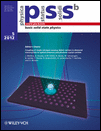
PHYSICA STATUS SOLIDI B-BASIC SOLID STATE PHYSICS
Exploring the Foundations of Solid State PhysicsPHYSICA STATUS SOLIDI B-BASIC SOLID STATE PHYSICS, published by Wiley-VCH Verlag GmbH in Germany, is an esteemed journal within the condensed matter physics sphere, covering pivotal advancements in basic solid state physics. With a rich history dating back to 1961, it serves as a scholarly platform for researchers, professionals, and students alike, providing insights into the fundamental properties and applications of electronic, optical, and magnetic materials. The journal currently holds a respectable Q3 ranking in both Condensed Matter Physics and Electronic, Optical, and Magnetic Materials as of 2023, indicating its impactful contributions to these fields despite its competitive landscape. While it does not offer open access, its comprehensive research findings are critical for those engaged in innovative material science research. With a convergence period extending to 2024, PHYSICA STATUS SOLIDI B continues to play a significant role in facilitating knowledge exchange and fostering advancements in solid state physics.

Computational Condensed Matter
Illuminating the Path for Future Innovations in Materials ChemistryComputational Condensed Matter, a reputable journal published by Elsevier, serves as a critical platform for advancing the understanding of condensed matter physics and related fields. Since its inception in 2014, the journal has become a pivotal resource for researchers and professionals dedicated to exploring electronic, optical, and magnetic materials, as well as materials chemistry and general materials science. With its current standing in the Q3 quartile across multiple categories in 2023, it ranks within the 60th percentile for Materials Science (miscellaneous) and the 54th percentile for Condensed Matter Physics in Scopus, reflecting its growing influence and relevance in the scientific community. The journal aims to publish high-quality, peer-reviewed articles that can foster innovation and collaboration in computational methods applied to condensed matter systems. Researchers interested in cutting-edge insights and methodologies will find Computational Condensed Matter to be an invaluable addition to their academic resources. For those seeking to contribute to or stay informed about the latest advancements in the field, this journal is a must-read.
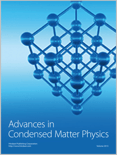
Advances in Condensed Matter Physics
Connecting Researchers with the Latest DiscoveriesAdvances in Condensed Matter Physics is a distinguished journal published by HINDAWI LTD, dedicated to the rapid dissemination of high-quality research in the field of condensed matter physics. Since its inception in 2008, this Open Access journal has facilitated wide accessibility to cutting-edge findings and theoretical advancements, with aims to foster collaboration and innovation within the scientific community. With an ISSN of 1687-8108 and an E-ISSN of 1687-8124, the journal covers an extensive range of topics, from quantum materials to nanotechnology, ensuring relevance and engagement across various sub-disciplines. As a testament to its impact in the field, it is ranked in the Q3 category for 2023 within Scopus and holds a position in the 34th percentile for physics and astronomy. The journal's continuous commitment to publishing significant exploratory research until 2024 makes it a pivotal resource for researchers, professionals, and students eager to stay on the leading edge of condensed matter physics advancements.

ACTA PHYSICA POLONICA A
Exploring Breakthroughs in General PhysicsACTA PHYSICA POLONICA A is a distinguished peer-reviewed journal published by the Polish Academy of Sciences Institute of Physics, offering a platform for disseminating cutting-edge research in the field of physics and astronomy. With an ISSN of 0587-4246 and an E-ISSN of 1898-794X, this journal has been a staple for scholars since its inception, converging its publication years from 1996 to 2024. Despite its current Q4 classification in the Physics and Astronomy (miscellaneous) category, ACTA PHYSICA POLONICA A provides valuable insights and breakthroughs addressing various aspects of general physics. Researchers, professionals, and students will find a wealth of knowledge within its pages, even as it operates in an evolving academic landscape. While subscription options exist, the journal aims to foster collaboration and knowledge exchange in the physics community, making it a vital resource for those seeking to stay at the forefront of research advancements.

Journal of Computational Electronics
Transforming Theoretical Frameworks into Practical SolutionsJournal of Computational Electronics, published by Springer, is a leading international journal that caters to the interdisciplinary field of computational modeling and simulation, particularly within atomic and molecular physics, electrical and electronic engineering, and electronic materials. Since its inception in 2002, the journal has established itself as an essential resource for researchers, professionals, and students, providing a platform for disseminating innovative research and advancing methodologies related to electronic systems. With its current Q3 ranking across multiple categories—including Atomic and Molecular Physics, Engineering, and Materials Science—the journal plays a significant role in shaping the future of computational approaches in relevant fields. While it is not an open access journal, its rigorous peer-review process ensures high-quality content, reflecting the latest advancements and insights. The Journal of Computational Electronics continues to contribute to scholarly discourse, supporting the development of cutting-edge technologies and theoretical frameworks essential for the evolving landscape of electronics.

JETP LETTERS
Fostering Breakthroughs in Theoretical and Experimental ScienceJETP LETTERS, published by MAIK NAUKA/INTERPERIODICA/SPRINGER, is a prestigious journal in the field of physics and astronomy, which plays a pivotal role in disseminating groundbreaking research and innovative ideas since its inception in 1969. With an ISSN of 0021-3640 and an E-ISSN of 1090-6487, this journal aligns well with the interests of both seasoned researchers and emerging scholars, having achieved a 2023 category rank of Q3 for miscellaneous topics within physics and astronomy. Located in the United States at 233 SPRING ST, NEW YORK, NY 10013-1578, JETP LETTERS serves as a critical resource for its readership, offering exclusive insights and advancements across diverse areas of physics. While not open access, it hosts a collection of articles that refine theoretical approaches and experimental methods, providing both knowledge and inspiration to professionals and academics seeking to make impactful contributions to the scientific community. The journal’s quality is reflected in its Scopus ranking, where it stands at 39 out of 81 in the multidisciplinary category, placing it in the 52nd percentile, thus underscoring its significance and reliability as a scholarly outlet.
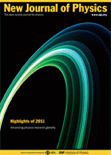
NEW JOURNAL OF PHYSICS
Connecting global minds through groundbreaking physics.NEW JOURNAL OF PHYSICS, published by IOP Publishing Ltd, is a prestigious open-access journal that has been at the forefront of the physics community since its inception in 1998. With an impact factor that places it in the Q1 category of Physics and Astronomy (miscellaneous) and a commendable ranking of #49 out of 243 in the general physics and astronomy category according to Scopus, this journal is recognized for its significant contribution to advancing research in the field. The journal caters to a broad scope of topics, providing a platform for the dissemination of cutting-edge research findings and innovative theoretical explorations. Operating from the United Kingdom, it offers a truly international perspective, making its contents accessible and impactful to a global audience. With robust open-access options, the NEW JOURNAL OF PHYSICS ensures that research findings are freely available, promoting collaboration and knowledge sharing among researchers, professionals, and students alike. This commitment to accessibility, combined with its high-quality content, makes it an essential resource for anyone engaged in the physics community.